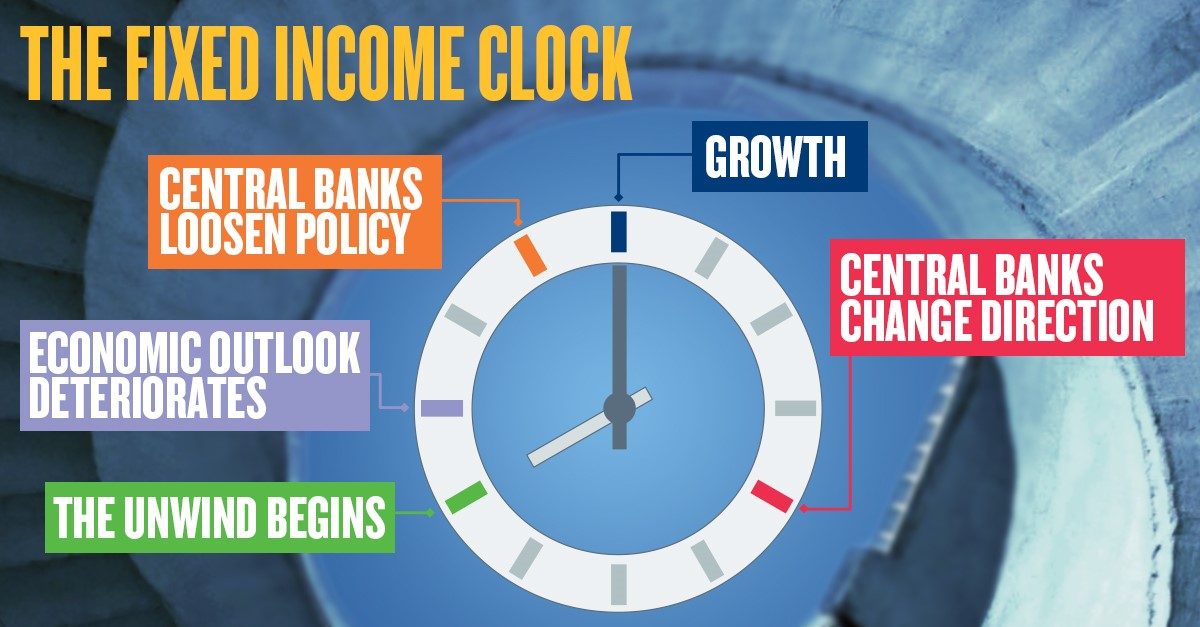There will be a number of factors influencing bond markets during 2019, but perhaps two might prove to be the most significant: first, the prospect of the Federal Reserve (Fed) having reached a plateau in its interest-rate policy and, second, a potential rise in default rates.
During 2018, the US Treasury market had to adjust, initially by selling off against the backdrop of a hawkish Fed in the first half of the year, and then by responding to the demise of risk assets and a government-bond rally into the year end. The fourth quarter confirmed the suggestion we made earlier in the year via our referencing of a fixed-income ‘clock’, that tightening by a central bank is eventually more painful for the risk assets that have been inflated by previously loose monetary policy than for the government-bond market. Further tightening when the economy is past its best could lead to more problems for risk assets and greater demand for safe-haven government bonds.
The gap between bond yields and cash rates has narrowed to the point where the market appears to have reflected this state of affairs. Strong economic growth will not necessarily result in a significant rise in risk assets (beyond an over-sold bounce), as this may bring about a hawkish response from the central bank that in turn will dampen risk-asset performance. Meanwhile, the economy continues to grow and the Fed reduces its balance sheet as part of a less public tightening policy.
In China, the authorities play a game of withdrawing previous sources of liquidity and adding to others to maintain economic growth at close to 6%, while removing some of the previous excesses. This is going to be a very delicate balancing act and one that will, at best we think, benefit the domestic economy rather than the global economy. Any rapprochement in the ongoing US-Sino trade negotiations will perhaps offer some reprieve to the outlook.
In the near term, the Fed’s stance will dictate the total return of markets, and owing to their safe-haven nature, that of government-bond markets. On balance, however, we may have reached a short-term equilibrium.
Later in 2019, we continue to believe that the higher borrowing and production costs weighing on companies (especially in the US) will act as a drag on investment and lead to slower growth and higher default rates. As the bond-market cycle clock ticks on (see below), we think the high-yield bond markets will need to adjust further owing to the extent of leverage in the asset class, and, consequently, the government-bond rally could resume. We would expect the performance of investment-grade corporate bonds and emerging-market sovereign bonds to lie somewhere between the two previously mentioned bond asset classes over the course of 2019.

This is a financial promotion. Material in this publication is for general information only. The opinions expressed in this document are those of Newton and should not be construed as investment advice or recommendations for any purchase or sale of any specific security or commodity. Certain information contained herein is based on outside sources believed to be reliable, but its accuracy is not guaranteed. You should consult your advisor to determine whether any particular investment strategy is appropriate. This material is for institutional investors only. Any reference to a specific security, country or sector should not be construed as a recommendation to buy or sell this security, country or sector. Please note that strategy holdings and positioning are subject to change without notice. Compared to more established economies, the value of investments in emerging markets may be subject to greater volatility, owing to differences in generally accepted accounting principles or from economic, political instability or less developed market practices.
Important information
This is a financial promotion. Issued by Newton Investment Management Limited, The Bank of New York Mellon Centre, 160 Queen Victoria Street, London, EC4V 4LA. Newton Investment Management Limited is authorized and regulated by the Financial Conduct Authority, 12 Endeavour Square, London, E20 1JN and is a subsidiary of The Bank of New York Mellon Corporation. 'Newton' and/or 'Newton Investment Management' brand refers to Newton Investment Management Limited. Newton is registered in England No. 01371973. VAT registration number GB: 577 7181 95. Newton is registered with the SEC as an investment adviser under the Investment Advisers Act of 1940. Newton's investment business is described in Form ADV, Part 1 and 2, which can be obtained from the SEC.gov website or obtained upon request. Material in this publication is for general information only. The opinions expressed in this document are those of Newton and should not be construed as investment advice or recommendations for any purchase or sale of any specific security or commodity. Certain information contained herein is based on outside sources believed to be reliable, but its accuracy is not guaranteed. You should consult your advisor to determine whether any particular investment strategy is appropriate. This material is for institutional investors only.
Personnel of certain of our BNY Mellon affiliates may act as: (i) registered representatives of BNY Mellon Securities Corporation (in its capacity as a registered broker-dealer) to offer securities, (ii) officers of the Bank of New York Mellon (a New York chartered bank) to offer bank-maintained collective investment funds, and (iii) Associated Persons of BNY Mellon Securities Corporation (in its capacity as a registered investment adviser) to offer separately managed accounts managed by BNY Mellon Investment Management firms, including Newton and (iv) representatives of Newton Americas, a Division of BNY Mellon Securities Corporation, U.S. Distributor of Newton Investment Management Limited.
Unless you are notified to the contrary, the products and services mentioned are not insured by the FDIC (or by any governmental entity) and are not guaranteed by or obligations of The Bank of New York or any of its affiliates. The Bank of New York assumes no responsibility for the accuracy or completeness of the above data and disclaims all expressed or implied warranties in connection therewith. © 2020 The Bank of New York Company, Inc. All rights reserved.





